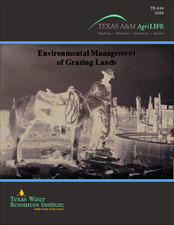| dc.description.abstract | Bacteria levels are the number one cause of water quality impairment in Texas. Several recent Total Maximum Daily Loads (TMDLs) in Texas, such as those implemented in the Peach Creek and Leon River watersheds, have identified grazing cattle as a contributor to bacterial water quality impairments in those watersheds through both direct deposition and runoff of their fecal matter to streams. To address this issue, the Texas State Soil and Water Conservation Board (TSSWCB) and the Natural Resources Conservation Service (NRCS) funded this project to assist with development and delivery of technical information and support to ranchers on protection and enhancement of the functions and values of grasslands.
A number of best management practices (BMPs) have been identified to reduce bacteria runoff from grazing lands and direct deposition into streams. The primary focus of these BMPs is to maintain adequate ground cover and minimize concentrated livestock areas, especially on sensitive areas such as riparian areas. Maintaining adequate ground cover and plant density improves the filtering capacity of the vegetation and enhances water infiltration into the soil. Minimizing concentrated livestock areas, trailing, and trampling reduces soil compaction, reduces excess runoff and subsequent soil erosion, and enhances fecal matter distribution and ground cover. Specific BMPs identified include grazing management, fencing, alternate water sources, hardened watering points, controlled access, supplemental feed placement, and shade or cover manipulation (NRCS 2007).
This project accomplished several objectives, including: 1) compiling existing information on environmental management of grazing lands, 2) evaluating and demonstrating the effectiveness of proper grazing management in reducing bacterial runoff from grazing lands, 3) initiating evaluation of the effect of complementary practices (i.e. alternative water supplies and shade) on cattle behavior and stream water quality, and 4) promoting adoption of appropriate grazing land management practices.
Evaluation and demonstration of the effect of grazing management on bacteria runoff at the USDA-ARS Riesel Watersheds has produced some interesting results. The site mean concentration of E. coli (i.e. flow weighted concentration) at the ungrazed native prairie site was surprisingly high (1.0E+04 cfu/100 ml), greatly exceeding the Texas Surface Water Quality Standards single sample standard for E. coli (394 cfu/100 ml) as well as the geometric mean (126 cfu/100 ml). It is important to note that these standards apply to waterbodies, such as streams and reservoirs, but not to edge-of-field runoff as described here. Also, the E. coli concentration seen in the runoff from the moderately grazed bermudagrass site (2.3E+04 cfu/100 ml) was significantly higher (more than double) than that observed at the native prairie site. These levels, however, are consistent with the findings of other researchers.
The pre-BMP implementation evaluation of the effectiveness of alternative water supplies and shade on cattle behavior and stream water quality (E. coli) has been completed at the 2S Ranch, near Lockhart. This evaluation showed that when alternative water was not available, E. coli levels increased as the stream flowed through the ranch. Quarterly evaluation of cattle behavior using GPS collars indicated cattle spent only 4.5% of the time within 35 feet of the stream when alternative water was not available.
When alternative water was provided, however, this percent time that cattle spent within 35 feet of the stream was reduced to 1.1%, a 75% reduction. This reduction is consistent with the findings of other researchers. Post-BMP evaluation has been initiated and will continue for another year now that alternative water and shade has been provided.
Much was done through this project to increase awareness of the bacteria issue and BMPs to address them. AgriLife Extension and TWRI developed fact sheets, provided posters and presentations, conducted site tours, and developed a Web site to help disseminate information. These outreach activities reached local, state, and national audiences. The Web site alone has reached 539 unique visitors during the project.
Much is left to do, however. Evaluation of grazing management, alternative water supplies, and shade will continue. Data on other practices (i.e. using rip-rap to reduce access to riparian areas, providing controlled access points, etc.) and groups of practices is still needed to provide cattlemen with a “toolbox” for addressing the bacteria issue. Modification of water quality standards may also be appropriate to address the high levels of E. coli found in runoff from ungrazed sites. Education programs need to be conducted state- and nation-wide to assist cattlemen in addressing bacteria issues. | en |


